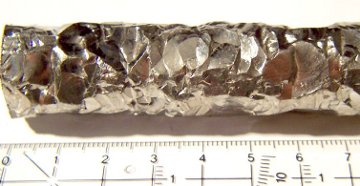
Zirconium
Zirconium General
| Name:Zirconium | Symbol:Zr |
| Type:Transition Metal | Atomic weight:91.22 |
| Density @ 293 K:6.52 g/cm3 | Atomic volume:14 cm3/mol |
|
Discovered:
Zirconium was first recognized as a new element by Martin Heinrich Klaproth in 1789 in a sample of zircon (zirconium silicate). The metal was first isolated by Jons J. Berzelius in 1824. The element name comes from the Persian word 'zargon', meaning gold-like. |
|
Zirconium States
| State (s, l, g):solid | |
| Melting point:2123 K (1850 °C) | Boiling point:4673 K (4400 °C) |
Zirconium Energies
| Specific heat capacity:0.27 J g-1 K-1 | Heat of atomization: 609 kJ mol-1 |
| Heat of fusion:16.90 kJ mol-1 | Heat of vaporization :590.5 kJ mol-1 |
| 1st ionization energy:640.1 kJ mol-1 | 2nd ionization energy:1266.8 kJ mol-1 |
| 3rd ionization energy:2218.2 kJ mol-1 | Electron affinity:41.1 kJ mol-1 |
Zirconium Oxidation & Electrons
| Shells:2,8,18,10,2 | Electron configuration:[Kr] 4d2 5s2 |
| Minimum oxidation number:0 | Maximum oxidation number:4 |
| Min. common oxidation no.:0 | Max. common oxidation no.:4 |
| Electronegativity (Pauling Scale): 1.33 | Polarizability volume: 17.9 Å3 |
Zirconium Appearance & Characteristics
| Structure:hcp: hexagonal close pkd | Color:grayish-white |
| Hardness:5.0 mohs | |
|
Harmful effects:
Zirconium is considered to be non-toxic. |
|
|
Characteristics:
Zirconium is a strong, malleable, ductile, lustrous, grayish-white metal. It is generally exceptionally resistant to corrosion. It is however rapidly attacked by hydrofluoric acid, even at low concentrations. Uses: Zirconium is very poor at absorbing neutrons. It is therefore useful in nuclear energy applications such as in the cladding (outer layer) of fuel rods through which it is important that neutrons can travel easily. |
|
Zirconium Reactions
| Reaction with air:mild, w/ht ⇒ Zr2O3 | Reaction with 6 M HCl:none |
| Reaction with 15 M HNO3: passivated | Reaction with 6 M NaOH:none |
Zirconium Compounds
| Oxide(s):ZrO2 | Chloride(s):ZrCl3, ZrCl4 |
| Hydride(s):ZrH2 |
Zirconium Radius
| Atomic radius:160 pm | Ionic radius (1+ ion):pm |
| Ionic radius (2+ ion):pm | Ionic radius (3+ ion):88.5 pm |
| Ionic radius (2- ion):pm | Ionic radius (1- ion):pm |
Zirconium Conductivity
| Thermal conductivity:22.7 W m-1 K-1 | Electrical conductivity: 2.3 x 106 S m-1 |
Zirconium Abundance & Isotopes
| Abundance earth's crust:165 parts per million by weight, 38 parts per million by moles | |
| Abundance solar system: 40 parts per billion by weight, 0.5 parts per billion by moles | |
| Cost, pure:$157 per 100g | |
| Cost, bulk:$16 per 100g | |
|
Source:
Zirconium does not occur free in nature. Its chief mineral is zircon (zirconium silicate, ZrSiO4). It is produced commercially by reduction of the chloride with magnesium in the Kroll process. |
|
|
Isotopes:
Zirconium has 25 isotopes whose half-lives are known, with mass numbers 81 to 105. Of these, four are stable: 90Zr, 91Zr, 92Zr and 94Zr. The most naturally abundant is 90Zr at 51.5%. |
|
Zirconium Other
|
Other:
|
|
Prev: Yttrium Next: Niobium |